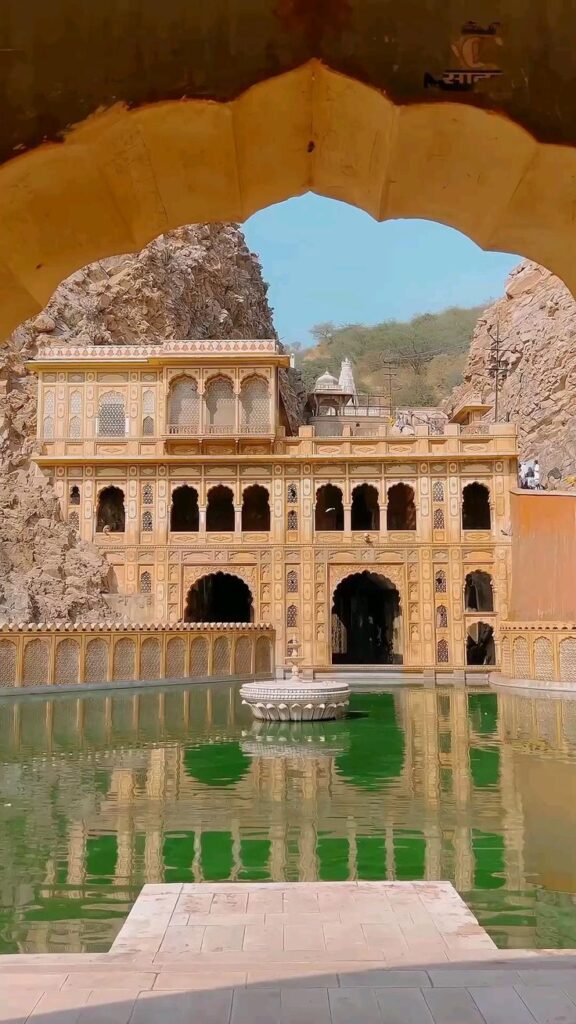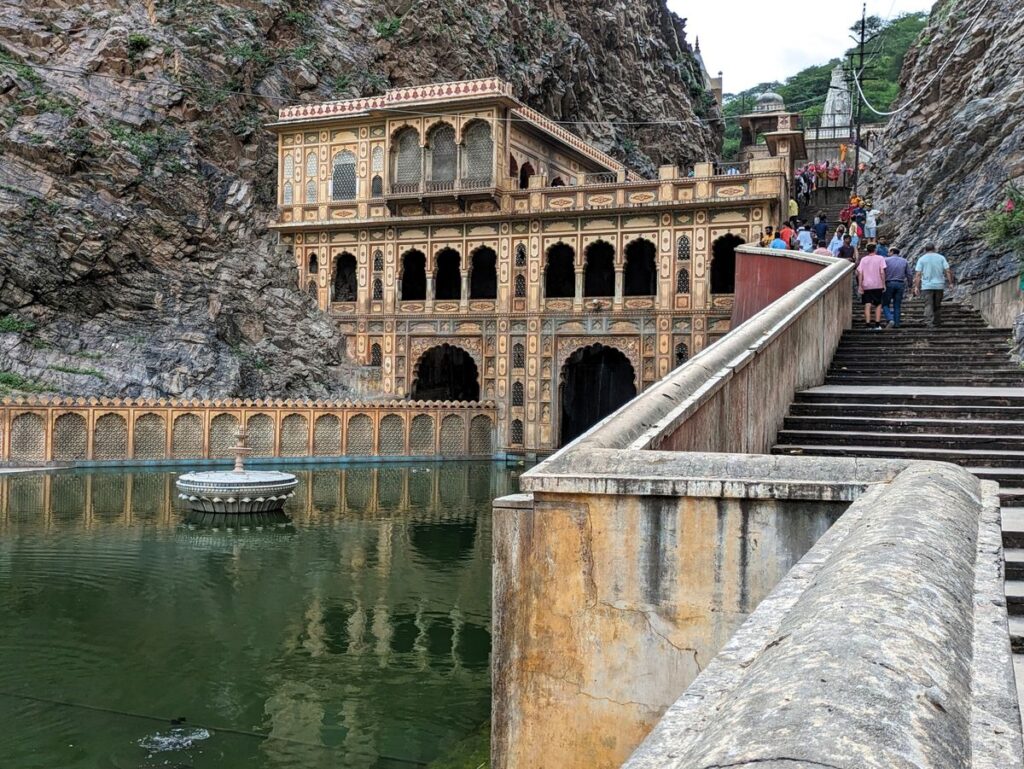The Pink City Jaipur is a dream destination for travelers who love history, culture, and tradition. Famous for its majestic forts and palaces, Jaipur also holds a deep spiritual significance with its temples and sacred shrines. Among them, the Galtaji Temple Jaipur, popularly known as the Monkey Temple, stands out as a peaceful retreat and holy pilgrimage site.
Built in the 16th century, Galtaji Temple is a fascinating blend of architecture, mythology, and natural beauty. Nestled in the Aravalli Hills, the temple complex is known for its natural springs, sacred kunds (water tanks), and playful monkeys. This travel guide covers everything you need to know about Galtaji Temple Jaipur — from its history and architecture to timings, travel tips, and FAQs.

History of Galtaji Temple Jaipur
The history of Galtaji Temple dates back nearly 400 years. It was built by Diwan Rao Kriparam, a courtier of Sawai Jai Singh II, to honor Saint Galav. According to legends, the sage Galav spent more than 100 years in meditation here.
It is believed that the gods, impressed by his devotion, blessed him with a natural spring of water that never dries. This sacred spring became the source of the temple’s holy kunds, where thousands of devotees come to bathe every year.
Architecture of Galtaji Temple
The architecture of Galtaji Temple Jaipur is breathtaking. Built in pink sandstone, it resembles a grand haveli with sprawling courtyards, pillared pavilions, and intricate frescoes.
Key Architectural Features:
- Seven Kunds (Holy Tanks): The most famous is Galta Kund, which is considered sacred and never dries up.
- Shrines of Deities: Dedicated to Lord Hanuman, Lord Ram, Lord Krishna, and Surya Dev.
- Fresco Paintings: Depicting mythological stories and Rajasthani art.
- Natural Setting: Built amidst rocky hills, offering panoramic views of Jaipur.
This blend of nature and devotion makes it one of the most unique temples in Jaipur.
The Sacred Kunds of Galtaji Temple
The kunds (water tanks) are the lifeline of the temple. The natural spring water cascades down the hills and collects in these tanks, which are considered holy.
- Galta Kund: The holiest tank, believed to purify sins.
- Other Kunds: Used by pilgrims for ritual baths.
- Spiritual Importance: On Makar Sankranti, thousands gather to take a dip in these sacred waters.
Why is it Called Monkey Temple Jaipur?
Galtaji Temple is famously known as the Monkey Temple Jaipur because it is home to hundreds of monkeys. Both rhesus macaques and langurs roam freely around the temple complex.
Tourists often enjoy their playful activities, and many even feed them bananas and nuts. However, it is advised not to carry food openly, as monkeys may snatch it.
Location of Galtaji Temple Jaipur
- Address: Galta Ji, Jaipur, Rajasthan – 302031
- Distance from Jaipur City Center: ~10 km
- Nearby Attraction: Sisodia Rani Garden (often combined in one trip)
How to Reach Galtaji Temple Jaipur
- By Auto/Taxi: Easily available from Jaipur city center.
- By Local Bus: Buses run till Galta Gate, followed by a short hike.
- By Trek: Adventurous visitors often trek from Sun Temple side to reach.
Timings & Entry Fee
- Temple Timings: 5:00 AM – 9:00 PM daily
- Entry Fee: Free (nominal charges for photography & videography)
- Best Time to Visit: October – March (pleasant weather); mornings/evenings are best
Religious Significance
Galtaji is one of the most important Hindu pilgrimage sites in Jaipur. It is believed that a dip in the kunds during holy occasions brings spiritual blessings and prosperity. The temple is especially crowded during Makar Sankranti, when devotees take ritual baths and offer prayers.
Travel Tips for Galtaji Temple Visitors
- Wear comfortable shoes as the temple requires walking.
- Avoid carrying food openly to prevent monkeys from snatching.
- Carry a water bottle, especially in summer.
- Visit early morning for a peaceful experience.
- Dress modestly as it is a place of worship.
Rajasthan Tourism Official Site
Things to Do Near Galtaji Temple Jaipur
- Visit Sisodia Rani Garden – a royal garden nearby.
- Explore Sun Temple (Surya Mandir) – offers panoramic views.
- Take a trek in the Aravalli Hills.
- Explore Jaipur’s other famous temples like Birla Mandir and Govind Dev Ji.
For a complete city experience, check our guide: Top 10 Places to Visit in Jaipur
FAQs
Why is Galtaji Temple famous?
Because of its sacred kunds, natural spring, and monkeys, it is popularly called Monkey Temple.
Who built Galtaji Temple Jaipur?
Diwan Rao Kriparam in the 16th century.
How old is Galtaji Temple Jaipur?
Over 400 years old.
Which deities are worshipped at Galtaji Temple?
Lord Hanuman, Lord Ram, Lord Krishna, and Surya Dev.
What is the best time to visit Galtaji Temple?
October–March; mornings and evenings.
Is there any entry fee?
No, but camera charges may apply.
Can tourists bathe in the kunds?
Yes, but mainly devotees do so on occasions like Makar Sankranti.
Why is it called Monkey Temple Jaipur?
Due to the large monkey population residing there.
How far is Galtaji Temple from Jaipur railway station?
About 12 km.
Is Galtaji Temple safe for tourists?
Yes, but be cautious with monkeys.
Conclusion
The Galtaji Temple Jaipur is not just a temple but a unique cultural and spiritual treasure of Rajasthan. With its sacred kunds, grand architecture, monkeys, and serene surroundings, it offers a one-of-a-kind experience.
For those who want to go beyond Jaipur’s forts and palaces, the Monkey Temple Jaipur is a must-visit destination. It truly reflects the city’s spiritual essence and is a reminder of its deep cultural roots.
So next time you plan your trip, make sure to include the Galtaji Temple Jaipur in your itinerary for an unforgettable journey.

